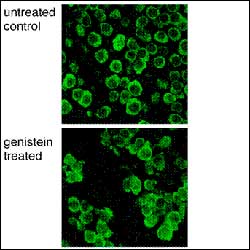Component in soy products causes reproductive problems in laboratory mice

This illustration depicts normal egg cell development in mice as schown in the top: the bottom image shows the genistein-treated animals where the abnormal egg clustering occurs.
Genistein, a major component of soy, was found to disrupt the development of the ovaries in newborn female mice that were given the product. This study adds to a growing body of literature demonstrating the potentially adverse consequences of genistein on the reproductive system.
“Although we are not entirely certain about how these animal studies on genistein translate to the human population, there is some reason to be cautious,” said Dr. David A. Schwartz, Director of the National Institute of Environmental Health Sciences (NIEHS). “More clinical studies are needed to determine how exposure during critical windows of development can impact human health.”
Genistein is the primary naturally occurring estrogen in plants (called phytoestrogens) and can mimic the effects of estrogen in the body. Genistein can be found in foods containing soy such as soy-based infant formulas as well as over-the-counter dietary supplements.
The results of this study conducted by researchers at the National Institute of Environmental Health Sciences (NIEHS), part of the National Institutes of Health, in collaboration with an investigator at Syracuse University, are published in the January issue of Biology of Reproduction.
The NIEHS researchers previously showed that mice given genistein immediately after birth had irregular menstrual cycles, problems with ovulation, and problems with fertility as they reached adulthood. The new study looks at the direct effects of genistein on the ovaries during early development.
“We knew genistein was linked to reproductive problems later in life, but we wanted to find out when the damage occurs,” said Retha R. Newbold, MS, a developmental endocrinologist at NIEHS and an author on the study. “The study showed that genistein caused alterations to the ovaries during early development, which is partly responsible for the reproductive problems found in adult mice.”
Female mice were injected with three different doses of genistein during their first five days of life. The genistein given to the mice was comparable to what human infants might receive in a soy-based formula, which is approximately 6-9 mg/kg per day. The researchers examined the effects on days 2 through 6.
The researchers found effects at all levels. Mice treated with the high dose (Gen 50 mg/kg) were infertile and mice treated with lower doses were subfertile, meaning they had fewer pups in each litter, and fewer pregnancies. Mice receiving the highest level of genistein, 50 mg/kg per day, had a high percentage of egg cells that remain in clusters, unable to separate and therefore develop abnormally. The researchers explain that oocytes that remain in clusters are less likely to become fertilized based on previous research. The largest difference between the genistein treated and normal mice was found at six days of age where 57 percent of the egg cells in the non-treated ovaries were single or unclustered; and only 36 percent in the genistein treated group were single
We think genistein inhibits the oocytes or egg cells from separating apart,” said Wendy Jefferson, Ph.D. of NIEHS and lead researcher on the paper. “Since there are many egg cells in the same follicle instead of just one, the resources from the surrounding cells are spread too thin and they can’t get the support they need to become a mature functioning egg cell.”
“You need at least one good healthy single oocyte that is ovulated and fertilized by a sperm to get a healthy baby. Genistein seems to have a way of making this task very difficult,” said Newbold.
“I don’t think we can dismiss the possibility that these phytoestrogens are having an effect on the human population,” said Dr. Jefferson. “They may not show their effects or be detected until later in life, but chances are they are having an effect.”
Media Contact
All latest news from the category: Life Sciences and Chemistry
Articles and reports from the Life Sciences and chemistry area deal with applied and basic research into modern biology, chemistry and human medicine.
Valuable information can be found on a range of life sciences fields including bacteriology, biochemistry, bionics, bioinformatics, biophysics, biotechnology, genetics, geobotany, human biology, marine biology, microbiology, molecular biology, cellular biology, zoology, bioinorganic chemistry, microchemistry and environmental chemistry.
Newest articles

Silicon Carbide Innovation Alliance to drive industrial-scale semiconductor work
Known for its ability to withstand extreme environments and high voltages, silicon carbide (SiC) is a semiconducting material made up of silicon and carbon atoms arranged into crystals that is…

New SPECT/CT technique shows impressive biomarker identification
…offers increased access for prostate cancer patients. A novel SPECT/CT acquisition method can accurately detect radiopharmaceutical biodistribution in a convenient manner for prostate cancer patients, opening the door for more…

How 3D printers can give robots a soft touch
Soft skin coverings and touch sensors have emerged as a promising feature for robots that are both safer and more intuitive for human interaction, but they are expensive and difficult…





















